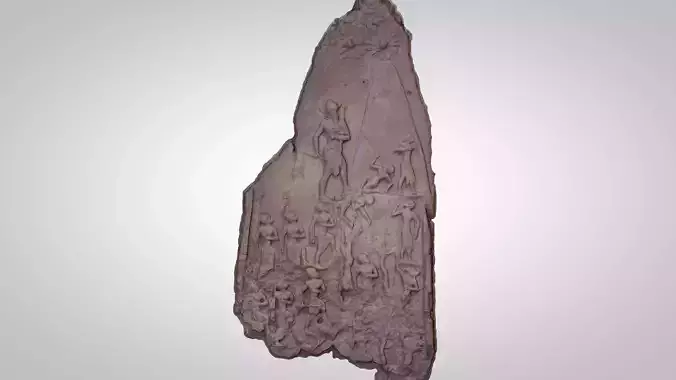1/33
The Victory Stele of King Naram-Sin is a fragmentary stele built in honour of the victory of Naram-Sin, king of the Akkadian Empire, over a rebellious people of the Zagros, the Lullubis.
Historical contextDuring the reign of Naram-Sin, the Lullubi people, living in the Zagros, rebelled. After putting down the revolt, the Akkadian king erected this stele in his honour at Sippar. In the 11th century B.C., it was taken away by the Medio-Elamite king Shutruk-Nahhunte and transported to Susa. He had an inscription engraved on it in Elamite, as on all the works he brought back from his expeditions, at the level of the mountain represented on the stele. The stele was found on 6 April 1898 by the archaeologist Jacques de Morgan on the tell of the Acropolis of Susa.
DescriptionThe victory stele of Naram-Sin is a major milestone in the sculpture of this period. It is the first known stela in bas-relief to be free from the notion of register. Thus, the story is no longer told scene by scene, but in one piece, bringing together in the same representation the arrival of the Akkadian troops, the battle, the defeat of the Lullubis and the triumph of Naram-Sin. Moreover, this stele is the first to put the king on the same level as the god. Thus, Naram-Sin is represented in heroic stature and wears a helmet adorned with horns, a symbol of divinity in the ancient Near East.
The stele, which is now fragmentary, must originally have been long and rounded at the top. At the top of the stele are stars (seven supposedly when the stele was complete), allegories of the gods watching over Akkad. Depicted in heroic stature overlooking the battle, Naram-Sin is distinguished from the soldiers by his divine headdress, a helmet with a pair of horns. He carries a bow and a spear and is dressed in a short loincloth suitable for battle. The king is clearly a warrior here. He is not only commanding the battle, he is participating in the battle. Naram-Sin is on top of a mountain (the Zagros) on which the battle is taking place. On the left flank, the Akkadians, on the right the Lullubis. The Akkadians are all shown identical, marching with a determined step towards the enemy, while the latter are in full rout. Some of the Lullubi beg the king to spare them, while others flee or fall under the blows of the Akkadians. One of them falls from the mountain, creating a vertical line separating the winners from the losers. Another collapses in front of Naram-Sin after receiving a spear in his throat.
The scene is clearly violent, characteristic of Akkadian art where defeated people are represented in chains, naked, if not executed. We also note the presence of decoration (a tree, the mountain) on the stele, which is also unusual.
REVIEWS & COMMENTS
accuracy, and usability.

































